The beautiful 3.5-mile round trip Kuilau Ridge Trail is a rainforest hike that takes hikers into the lush, vibrant, and green tropical interior of the island. It makes you feel like you’re in Jurrasic Park and although there are no giant predators, it’s also bug-free. In fact, it’s quite the opposite of what you think a hiking trail through a jungle would have (bugs and creature-wise) except for the mud.
I did this gradual uphill trail at the end of summer, and there are still mud puddles, slush, and slippery red dirt pretty much along the entire trail. The Kuilau trail itself, one way is just 1.75 miles to a footbridge, which is the end of the Kuilau trail but also the start of the Moalepe trail that continues on for another 2.75 miles to Olohena road in Kapaa.
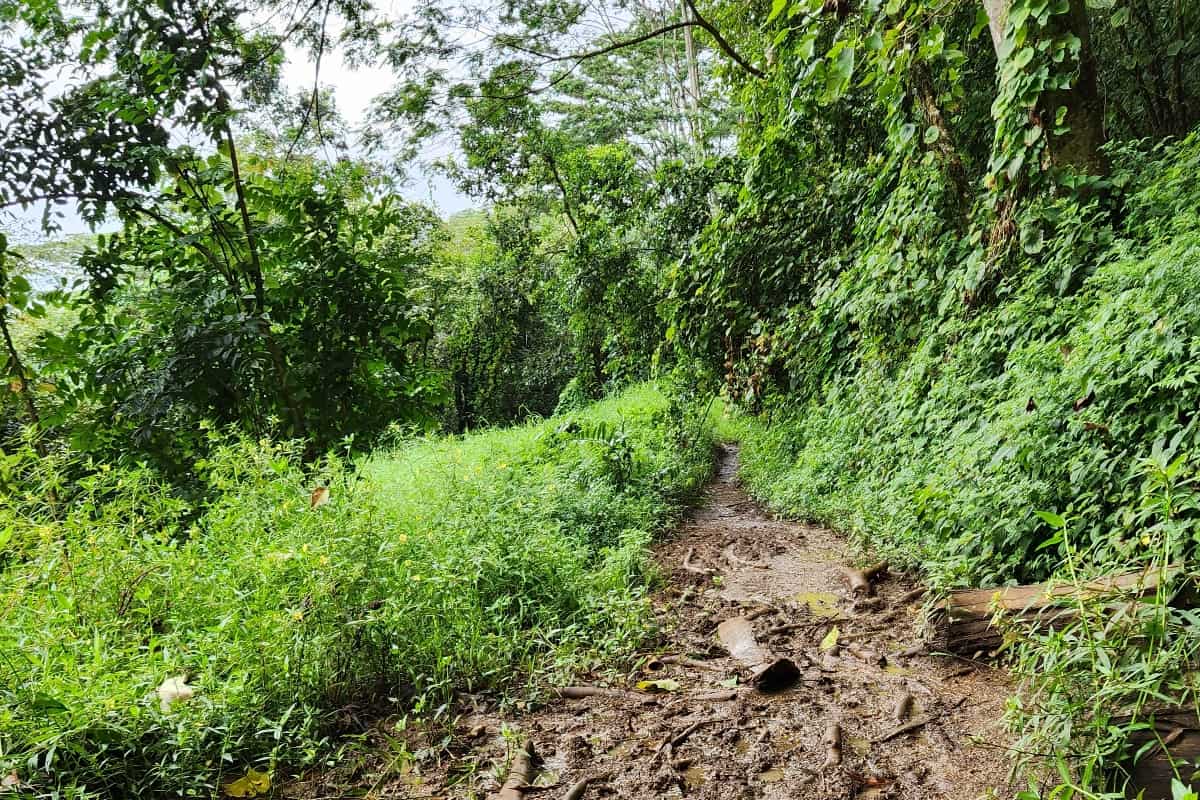
You can combine both of these trails as an out-and-back for an 8-mile round-trip adventure that includes seeing the beautiful mountain range of Waialeale and the Makaleha Mountains and the ocean for a couple of minutes on the Kuilau section. There is a lot more of the ocean towards the end of the Moalepe section.
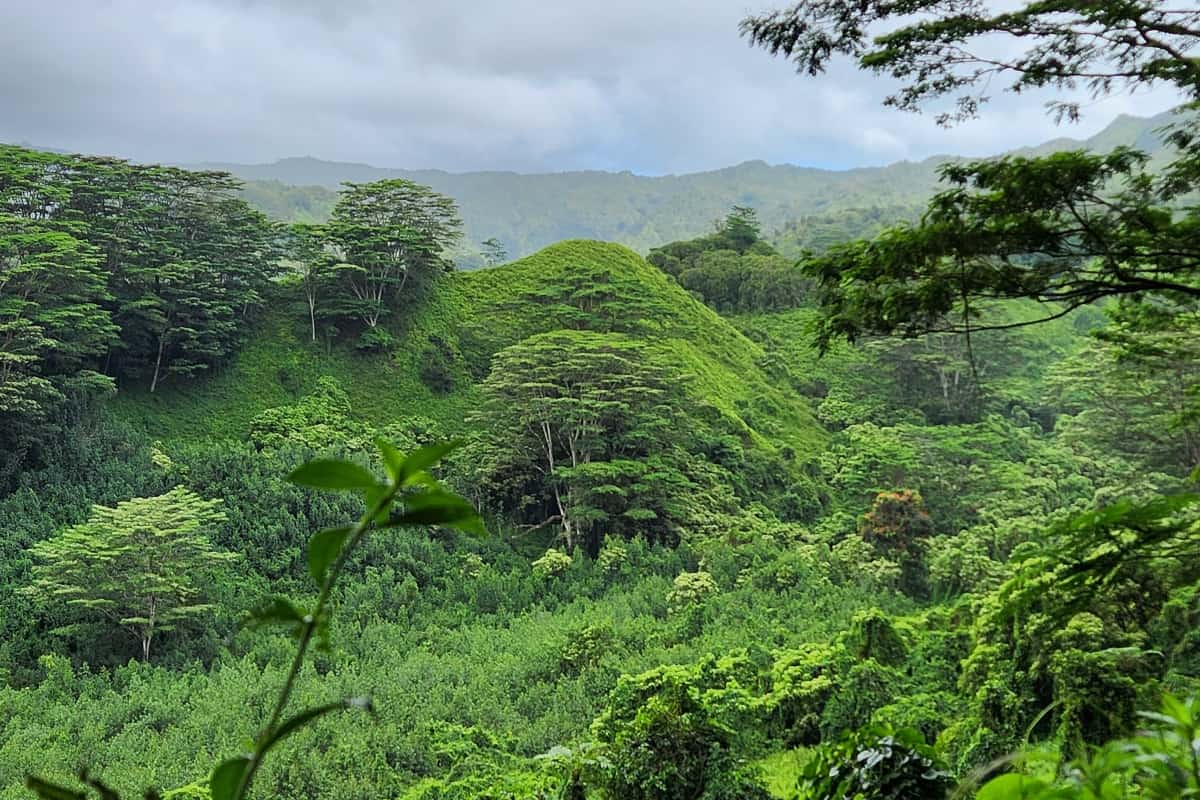
The Kuilau Ridge Trail only takes one in a half to two hours to complete, depending on if you stop to photograph or how many breaks you take. Many park a car at either end to complete both trails but avoid the 8 miles out and back.
The sheltered covered picnic tables are used not only as a spot to enjoy a break but as a stopping point and turn around for both trails. For the Kuilau Ridge hike, the picnic table is actually only 1.25 miles, and the end at the footbridge is another half a mile.
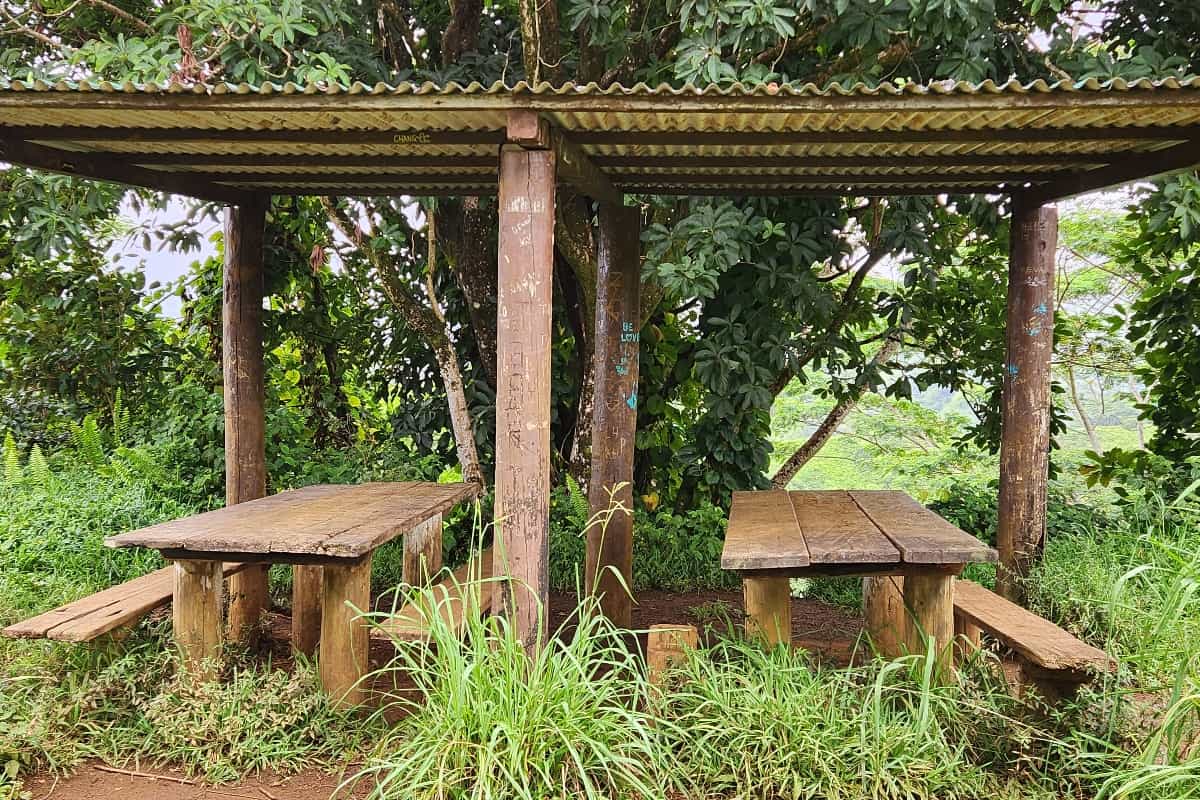
Kuilau Ridge Trailhead
Head up State Highway 580 off Highway 51 near Wailua in Kapaa. The Kuilau Ridge trailhead is within 6.6 miles and will be on your right. The parking lot only has room for four cars, so if you don’t find any open spaces then continue on for another 200 yards, where the road dead-ends at the Keahua Arboretum.
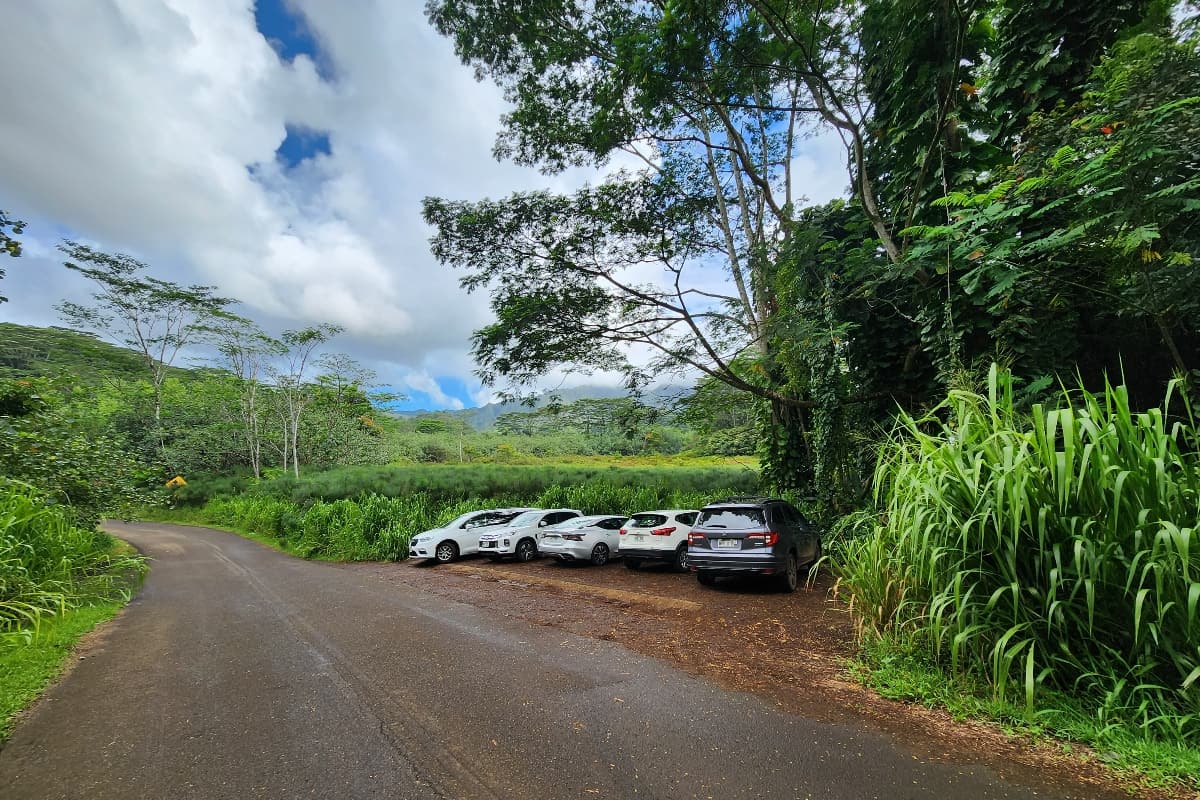
There, you will see another small parking lot to your left. You can also cross the bridge, and there’s another big parking lot to your right. At the Arboretum, there is a bathroom up a hill, lots of picnic tables, and a path to walk along that leads you through a forest of Rainbow Eucalyptus trees. The bridge goes over a river to cool off after you complete the hike, and you’ll probably want to do it due to muddy calves.
Whether you park at the trailhead or the Arboretum, you will come across a dirt road behind a gate that doesn’t allow vehicles but has an opening for people and even dogs. A leash is required, although I saw plenty of well-behaved dogs walking leash-free.
Kuilau Ridge Trail Hike
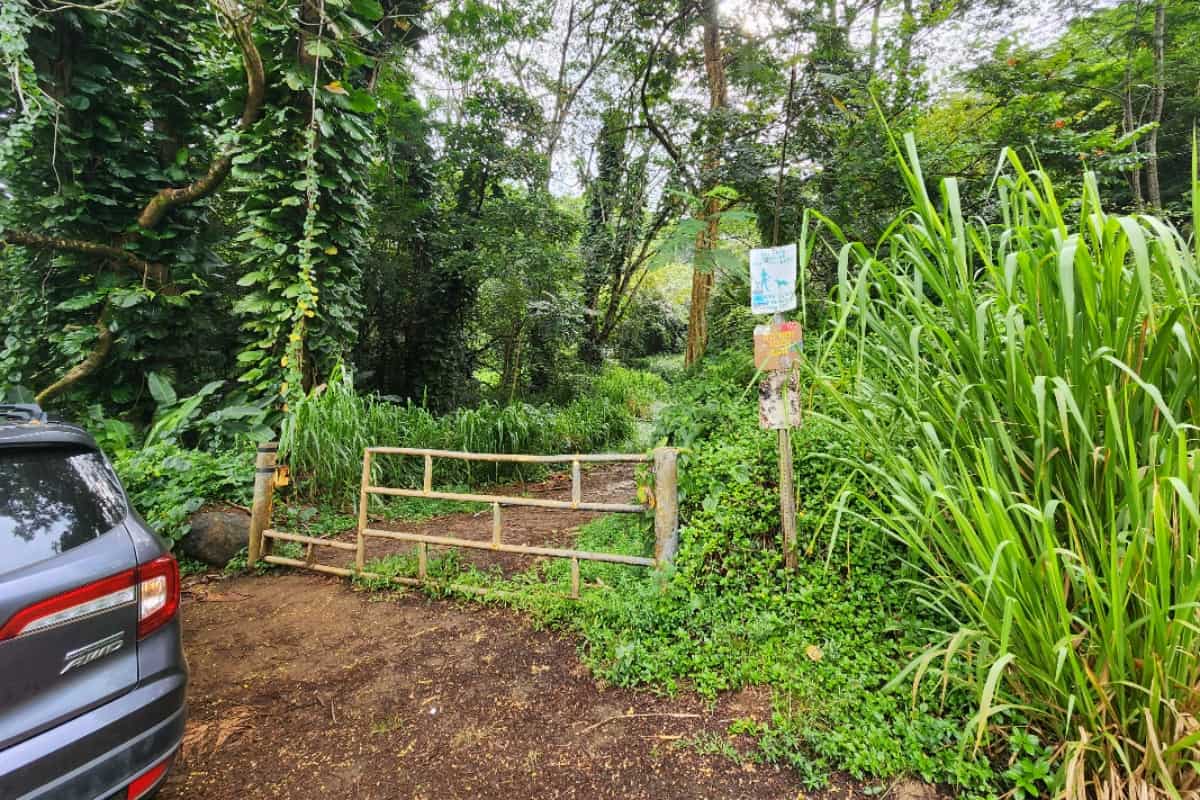
The dirt road starts out in a gradual uphill ascend right away. The Kuilau trail starts at 500 feet of elevation and gains 640 feet to end at 1140 feet at the shelter with the 2 picnic tables. This dirt road also starts to get muddy right away.
I have done the Kuilau Ridge Trail hike before in the winter and spring, which are considered the rainy season. It’ll get very muddy then, but the mud in late summer was easy to step over or around. Yet, still expect to get your calves, ankles, and shoes full of mud.
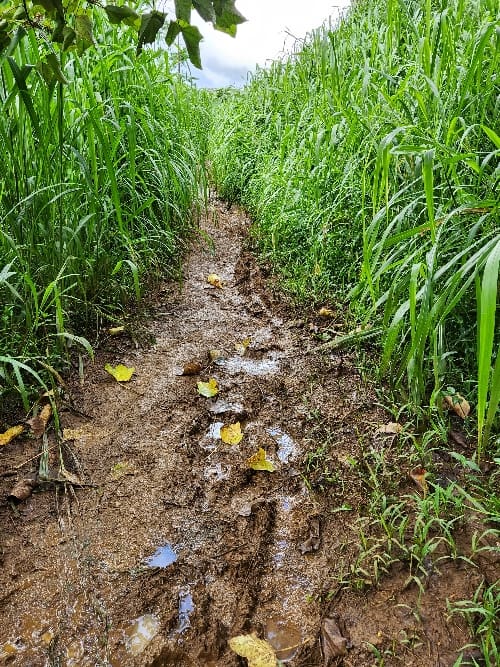
This trail is good for running, so obviously it’s graded easy to moderate. I still wear hiking boots because of the mud that I always come across on the trail and a few sections of tree roots that boots are better at dealing with. If you use hiking poles, they’re a great way to see how deep a slushy muddy part might be.
There are man-made hiking sticks left at the billboard 100 yards past the gate. Please feel free to use and leave for others. Here also is a poster of the Kuilau trail and additional information.
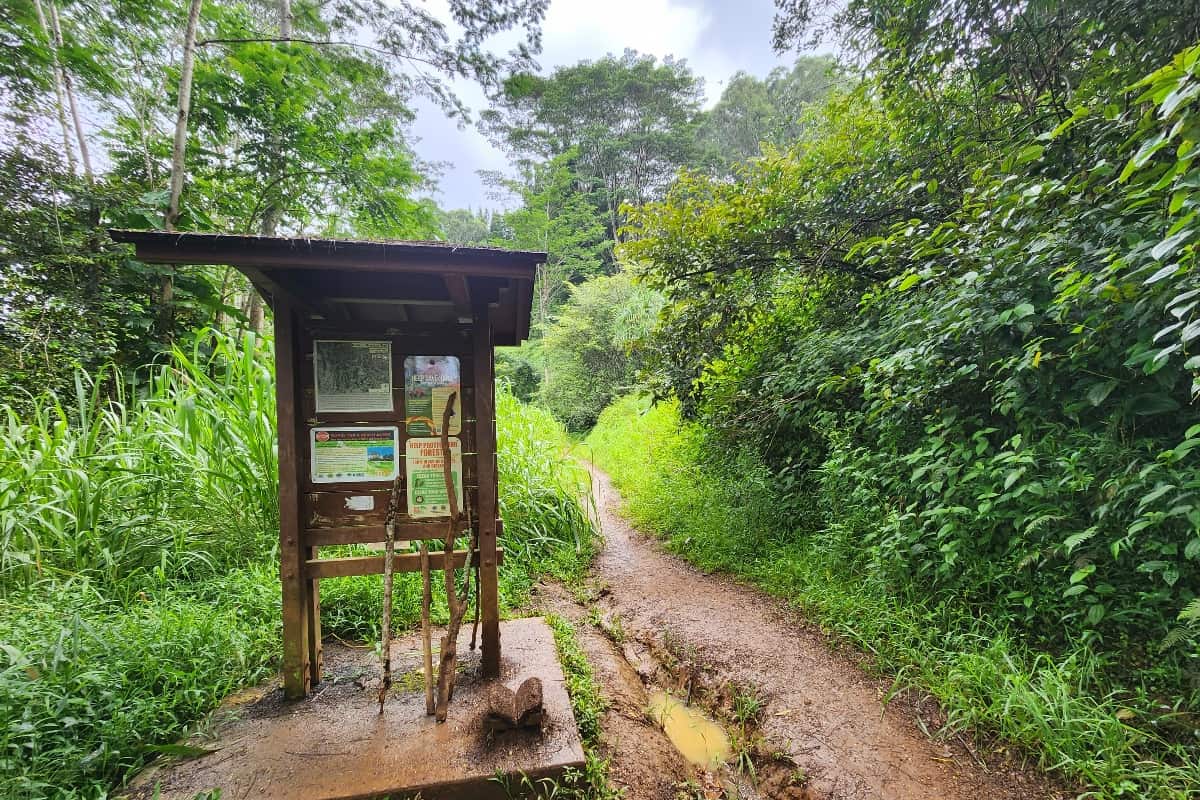
After this billboard, the trails quite frequently get narrow to wide. Again, it’s a rainforest, and there’s lots of overgrown plant life. The whole trail is maintained by the county so no need to bushwhack, even though there are sections of Buffalo grass that get 7 feet tall.
Just forage on and you’ll be fine. There are many different species of plant life along the trail and miles and miles of green-shaded plants and Ohia trees overlooking and leading to the mountain ranges. It’s here where you’ll think of Jurassic Park.
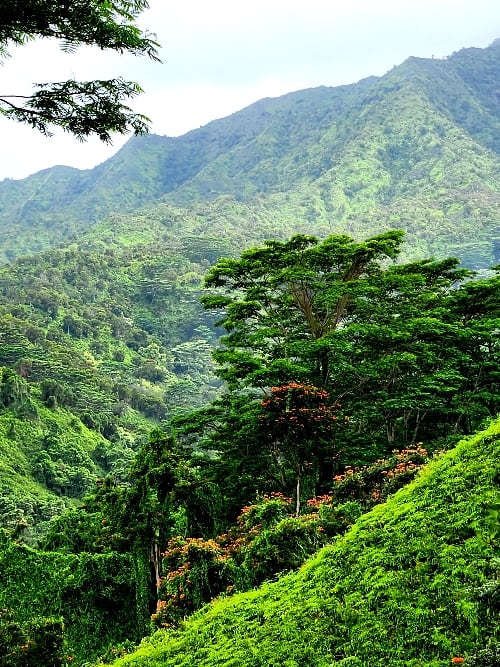
The most interesting plant life you can see is the huge ivy-type plant leaves that cover tree trunks all the way to the top. There is a section of Eucalyptus trees towering above you and creating a canopy that prevents you from getting wet if it starts raining.
Giant ferns are sprouting everywhere and dotted with wild red raspberries and their white flowers. Different types of Ginger can be found in yellow, red, and pink. I especially loved the small lavender flowers to photograph with raindroplets on their leaves. Listen along the trail to hear the song of different birds, with my favorite being the Shama Thrush.
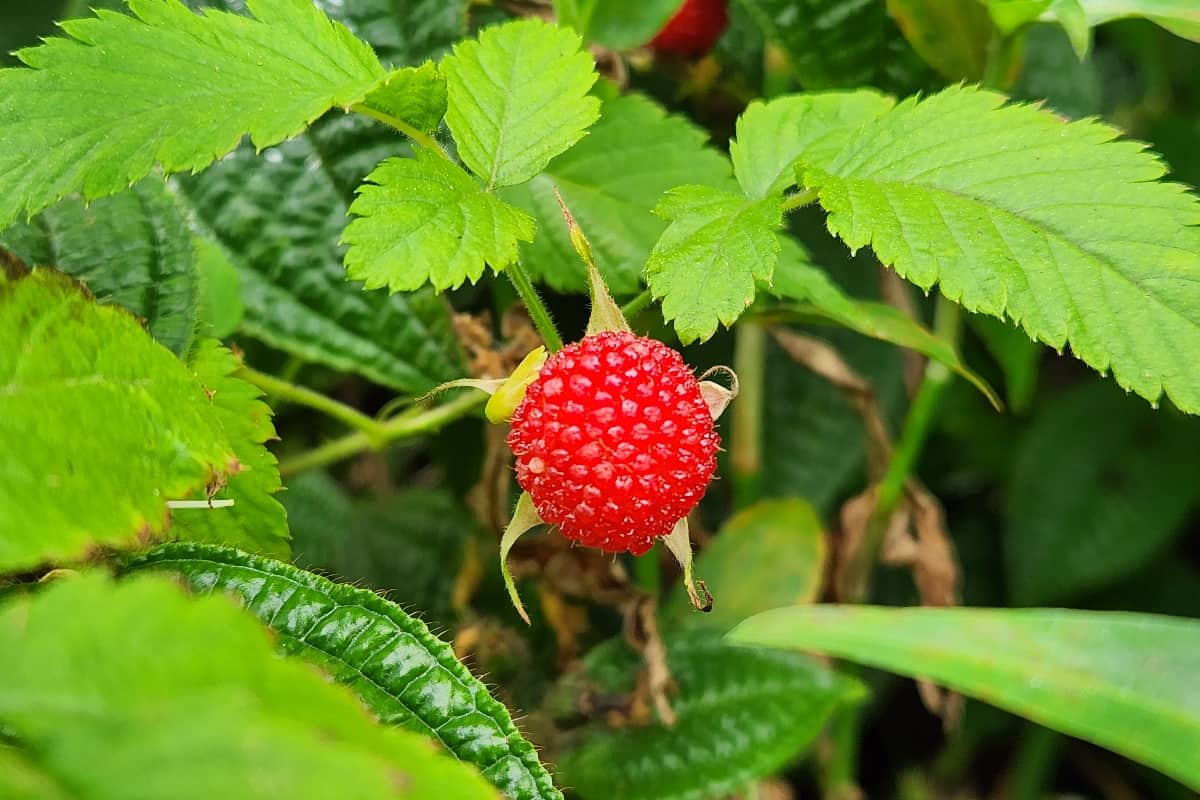
Yes, I mentioned raindrops. This section of Kapaa is the wettest, thanks to Mt Waialeale being so close, which is one of the wettest places on earth. When the Alakai swamp in Kokee gets too much rain it starts to overflow and causes the well-known Weeping Mountain.
We all have seen this above the north shore, but keep your eyes out for a surprise. The mountain ranges on your left as you continue the trail are always covered in clouds, just as you would expect from Mt Waialeale, a very wet area.
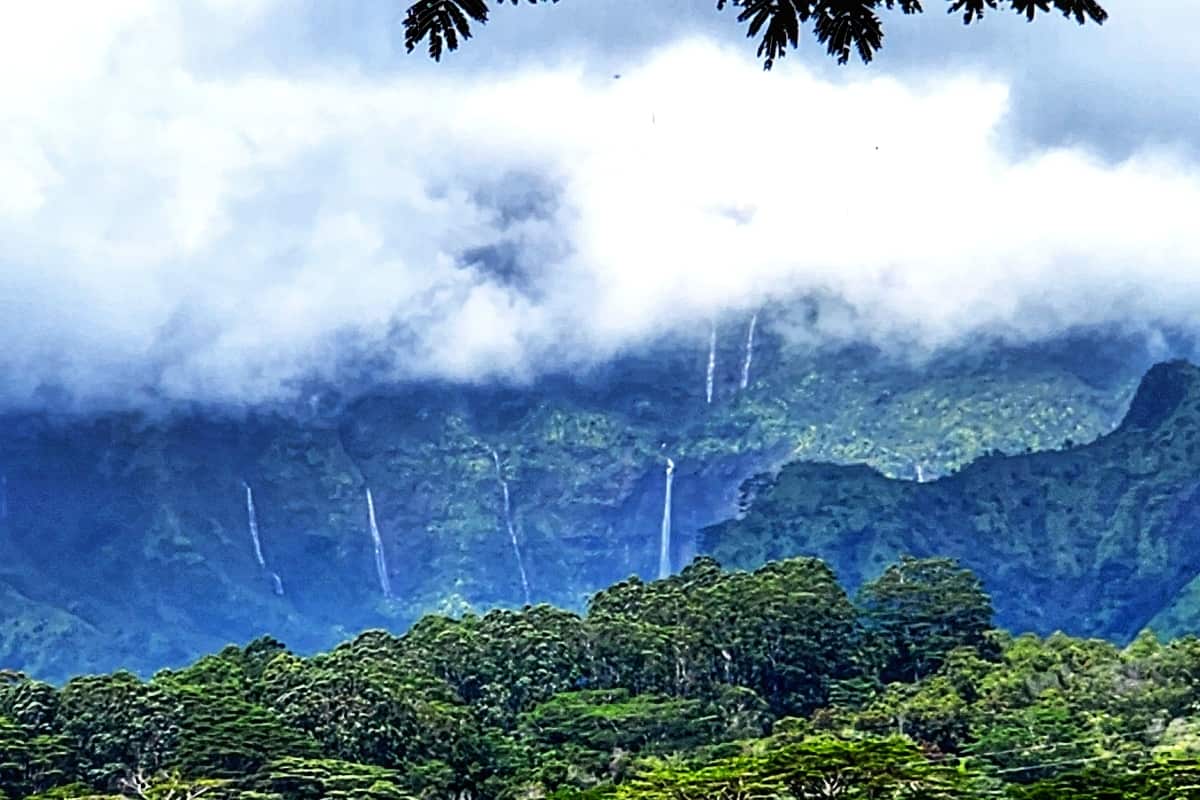
However, the hike gave me a tiny cloud clearing, and I got a glimpse of the multiple flowing waterfalls down these mountain ranges. It was a wonderful treat, so keep your eyes open to the distant Makaleha Mountains.
Back on the gradual uphill trail when you come to the shelter with the two picnic tables, rest, eat, and stare at the views.
End of the Kuilau Ridge Trail
You can ignore the 2 paths straight ahead as they become dead-ends quickly. Instead, take a quick right from the first table. It’s overgrown with Buffalo grass but merge through it for 100 yards and head downhill to the wooden footbridge to reach the end of the Kuilau Ridge Trail.
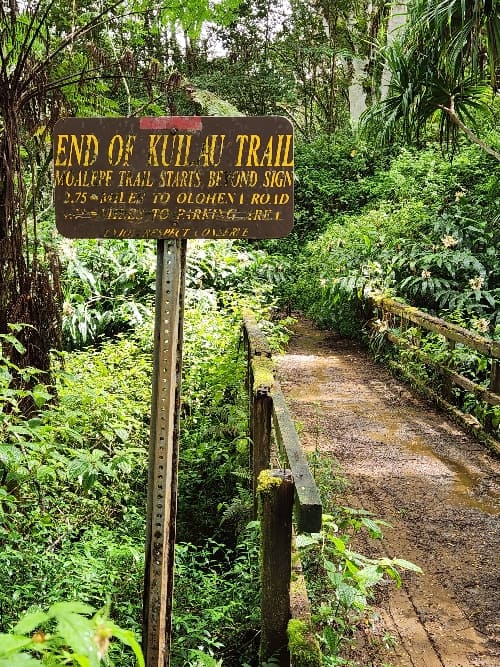
This half-mile trail is a winding one vs. the first 1.25 miles that is straight. This winding section is definitely more overgrown with the same rainforest plant life and a section of Ti Plant and Golden Pothos but also more beautiful trees that are dotted with the red African Tulip.
Here you’re close to the flowers with the peak of Kawaikini in the distance. The trail is still muddy and a bit more slick with hard red dirt, so watch your footing to avoid slipping and more tree roots along the path.
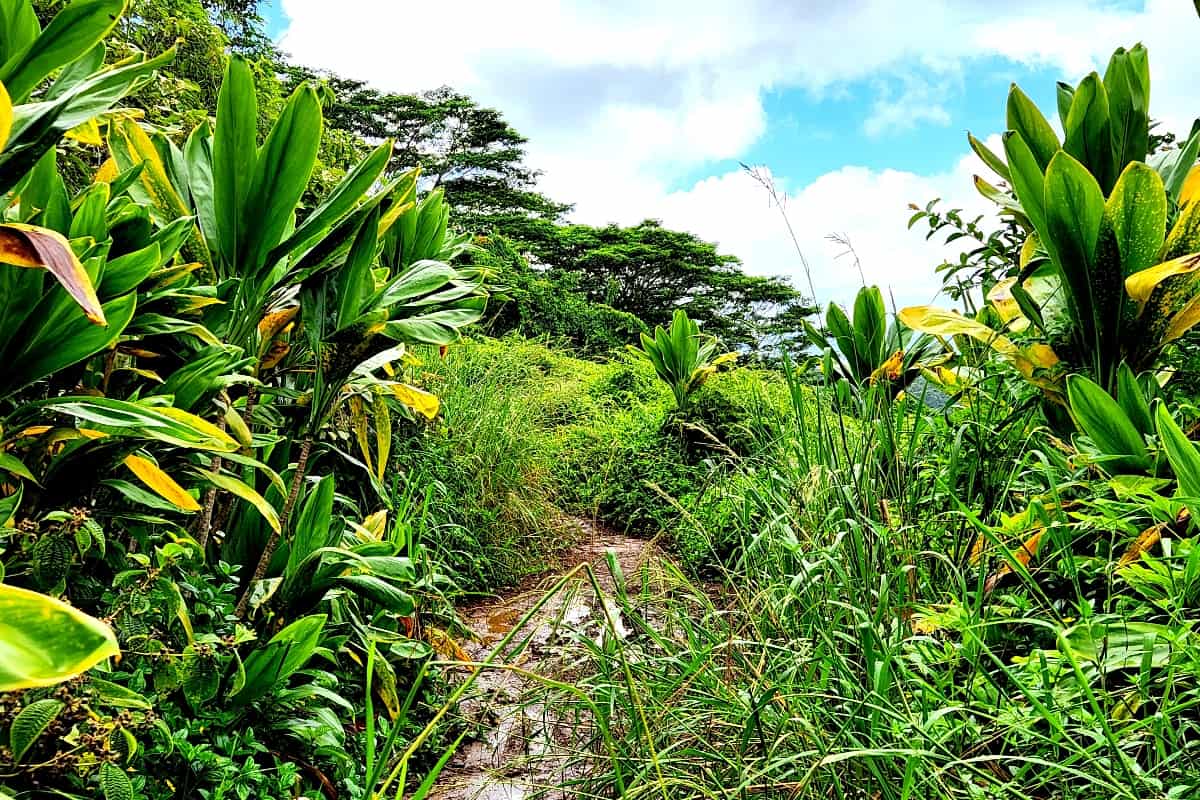
Very quickly, you can hear the water from the stream. There’s a wooden footbridge with sections covered with beautiful greens and yellow moss. Take some photos of the bridge and the stream, or just stand and listen to the Opaeka’a stream as you admire the pristine rainforest around you. You can continue on the Moalepe trail or turn around to head back to the gate at the trailhead.
Once you’re back in your car and if you parked at the gate, head to the Arboretum to explore this area that I mentioned at the beginning. Or head back down the highway and if you haven’t seen the famous Opaeka’a Falls, pull in. There, you’ll have public restrooms, and across the street is the Wailua River to watch all the canoes below heading to the Secret Falls trail.
Many who visit Kauai only consider hiking the Kalalau Trail or the Waimea Canyon Trail since they’re so beautiful and found along the Na Pali Coast or in the famous Waimea Canyon. However, Kapaa has the top rainforest hiking trails like the Kuilau Ridge Trail that give hikers memories of uniqueness that last forever and the thrilling feeling of the Jurassic Park world. If you’re looking for another hike in Kapa’a, explore the Sleeping Giant Nounou Mountain East Trail.
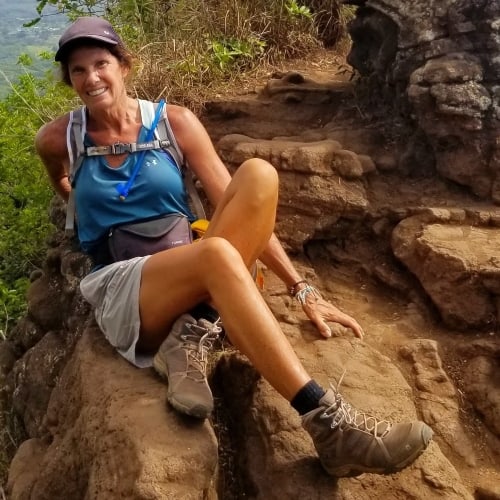
Written by: Debra Bowyer

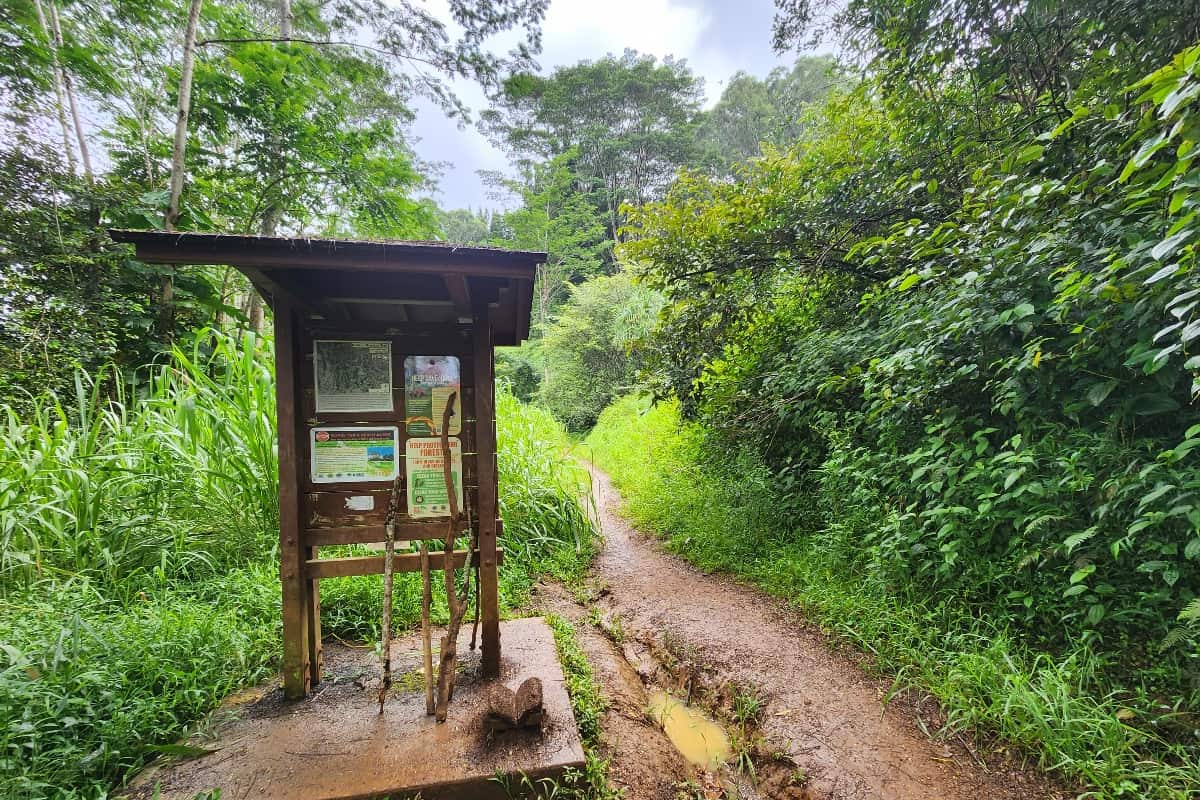
Leave a comment